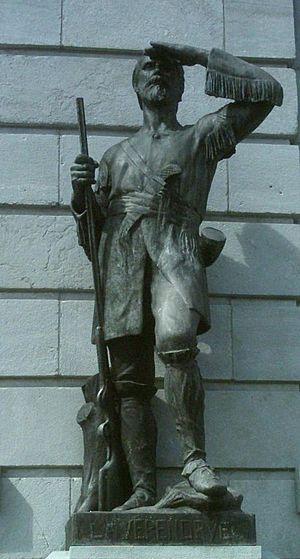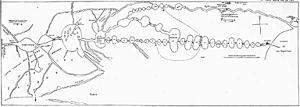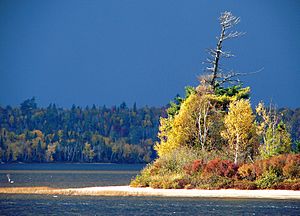Pierre Gaultier de Varennes, sieur de La Vérendrye facts for kids
Quick facts for kids
Pierre Gaultier de Varennes, sieur de La Vérendrye
|
|
|---|---|
| Born | 17 November 1685 Trois-Rivières, New France
|
| Died | 5 December 1749 (aged 64) |
Pierre Gaultier de Varennes, sieur de La Vérendrye (born November 17, 1685 – died December 5, 1749) was a brave French Canadian soldier, fur trader, and explorer.
In the 1730s, he and his four sons explored the lands west of Lake Superior. They set up many trading posts in this area. Their work helped add Western Canada to the French territory called New France. This original territory was mostly along the Saint Lawrence River.
La Vérendrye was the first European known to reach what is now North Dakota and the upper Missouri River in the United States. Later, in the 1740s, two of his sons traveled across the prairies. They went as far as present-day Wyoming, United States. They were the first Europeans to see the Rocky Mountains north of New Mexico.
Contents
Early Life and Military Service
Pierre was born in Trois-Rivières, New France. He was the youngest son of René Gaultier de Varennes, a soldier who came to Canada in 1665. His mother was Marie, whose father, Pierre Boucher, was the first Governor of Trois-Rivières. The Gaultier family were landowners from the Anjou area of France. Varennes and La Vérendrye were names of their family estates.
Pierre's father died when he was six years old. He studied at the Jesuit seminary in Quebec. When he was twelve, he became a cadet in the French Marines in Canada.
From 1704 to 1705, La Vérendrye fought in Queen Anne's War. This war was between English and French colonists in North America. He was part of the Raid on Deerfield in Massachusetts. The French and their Native American allies captured over a hundred people from the village. They forced them to walk 300 miles through the wilderness to Montreal. During these wars, both sides often took captives for ransom. The next year, La Vérendrye took part in an unsuccessful attack on the English settlement of St. John's, Newfoundland.
At 22, he joined the French Army. He fought in Flanders during the War of the Spanish Succession. He was badly hurt at the Battle of Malplaquet. After he got better and was released as a prisoner of war, Gaultier returned to Canada. In 1712, he married Marie-Anne, daughter of Louis Dandonneau, Sieur Du Sablé. For the next 15 years, he supported his family by farming and trading furs along the Saint Lawrence River.
Exploring the West

In 1726, La Vérendrye's luck changed. His brother, Jacques-René, became the commander of the poste du Nord. This area was the north shore of Lake Superior. It had three main trading posts. One was Fort Kaministiquia, a key starting point for journeys west. Another was near the Nipigon River, and a third near Wawa, Ontario.
La Vérendrye began trading in this area. In 1728, he became the commander when his brother left to fight the Fox Indians.
The Search for the Northwest Passage
La Vérendrye became very interested in finding a route to the Pacific Ocean. This route was known as the Northwest Passage. After the 1713 Treaty of Utrecht, the English controlled Hudson Bay. This meant the French could not use that area for trade.
At this time, people believed there was an inlet from the Pacific Ocean not far to the west. They called it the mer du couchant, or "western sea." They also thought explorers could cross a high piece of land and find a "River of the West." This river was believed to flow all the way to the Pacific.
Earlier explorers had tried to reach these western areas. In 1688, Jacques de Noyon reached Rainy Lake. In 1717, Zacharie Robutel de La Noue tried but only managed to set up Fort Kaministiquia. English traders on Hudson Bay heard about French fur traders west of Lake Superior. However, the French government had no official records of these journeys.
Planning the Expedition
La Vérendrye talked to the Native people who came to trade. He learned about the Mandan country on the upper Missouri River. These people were described as white men living in large houses. A Cree guide named Auchagah drew a map for La Vérendrye. It showed canoe routes between Lake Superior and Lake Winnipeg. La Vérendrye correctly guessed that Lake Winnipeg was the key to exploring further west.
In 1730, he met Governor Beauharnois in Quebec. Together, they made a plan. La Vérendrye would build a trading post on Lake Winnipeg. Quebec merchants would pay for the trip, hoping to make money from the fur trade. This funding was difficult because the merchants did not have enough money or organization to move supplies so far west. Another goal was to stop furs from being traded to the English on Hudson Bay. Without government money, exploration depended on the fur trade.
Journeys West
In 1731, La Vérendrye, three of his sons, and 50 workers left Montreal. That autumn, his son Jean-Baptiste built Fort St. Pierre on Rainy Lake. The next year, they built Fort St. Charles on Lake of the Woods. This fort became La Vérendrye's main base for several years.
In 1733, Jean-Baptiste got within 20 miles of Lake Winnipeg. However, he was stopped by ice and a lack of supplies. In 1734, their group finally reached Lake Winnipeg. Jean-Baptiste built Fort Maurepas near the mouth of the Red River, at the southern end of the lake. In 1734, La Vérendrye went to Quebec to sort out the money issues. He returned to the western post the following spring.
By 1734, more than half of the beaver furs reaching Quebec came from La Vérendrye's posts. But by 1736, the supply system was not working well. Jean-Baptiste had to go to Lake Superior for supplies. Sadly, he and eighteen other Frenchmen were killed by the Sioux at a place called Massacre Island on Lake of the Woods. La Vérendrye stopped the local Cree people from seeking revenge. He did this to protect the fur trade. In 1737, La Vérendrye went back to Quebec for business.
Reaching the Mandan and Rocky Mountains
In Paris, the French Minister of Marine, Maurepas, wanted more exploration. By this time, explorers thought two rivers might be the "River of the West." One was the Saskatchewan River, which flows east into Lake Winnipeg. The other was the Missouri River in the Mandan country, in what is now North Dakota, United States. The Mandan were said to live in large houses and look like Frenchmen. La Vérendrye chose to explore the Missouri route.
In September 1738, he reached Fort Maurepas on Lake Winnipeg. He then traveled up the Assiniboine River to Portage la Prairie. There, he built Fort La Reine just south of Lake Manitoba in October 1738.
La Vérendrye joined a large group of Assiniboines. He traveled southwest across the prairie. He reached a Mandan village, probably near modern New Town, North Dakota. This was about 70 miles east of the Montana border. He did not go all the way to the Missouri River himself. Instead, he sent his son Louis-Joseph. To get rid of their many Assiniboine guests, the Mandan claimed there was a Sioux war party nearby. The Assiniboines fled, taking the Cree interpreter with them. La Vérendrye could not talk to the Mandan. He left two Frenchmen to learn the language and returned to Fort La Reine in January 1739.
In 1740, he returned to Quebec for business. In 1741, he began his fourth and last journey west. From Fort La Reine, he sent his son Louis-Joseph to explore westward. Louis-Joseph likely reached the Big Horn Mountains of Wyoming in 1742–43. (You can read more about this journey in Verendrye brothers' journey to the Rocky Mountains.)
La Vérendrye worked to strengthen his control over the chain of lakes west of Lake Winnipeg. He built Fort Dauphin (Manitoba), Fort Bourbon, and Fort Paskoya. Back in France, Maurepas was getting annoyed with La Vérendrye. He thought La Vérendrye was spending too much time trading furs and not enough time exploring. In 1742, Maurepas suggested that La Vérendrye be replaced.
In 1743, La Vérendrye resigned. He returned to New France and lived as a gentleman. He continued to do a lot of business because his sons stayed as traders in the west. In 1746, he was given his old job back. He was planning a fifth expedition, this time up the Saskatchewan River, when he died on December 5, 1749. Shortly before his death, he received the Order of Saint Louis, a high honor.
After His Death

From 1744 to 1746, Nicolas-Joseph de Noyelles de Fleurimont was in charge of the poste du Nord, but he did not achieve much. After the elder La Vérendrye died, the new governor, Jonquière, forced his sons out of their father's trading posts.
Control of the west was given to Jacques Legardeur de Saint-Pierre (1750–53). He built Fort La Jonquière somewhere on the Saskatchewan River. However, he failed to travel further up that river. He was followed by Louis de la Corne, Chevalier de la Corne (1753-1756). He built Fort de la Corne on the Saskatchewan. In 1756, the western command was given to Pierre's son Louis-Joseph Gaultier de La Vérendrye. But he was unable to travel to the west.
During the French and Indian War (1754-1763), which was part of the Seven Years' War, the French slowly left their western posts. When France lost the war, the British took control of New France territory east of the Mississippi River.
Legacy and Honours

- A statue of Pierre Gaultier de Varennes, sieur de La Vérendrye, made by Joseph-Émile Brunette, is in Saint Boniface, Manitoba.
Many places are named in his honour:
- La Verendrye Provincial Park in Ontario
- La Vérendrye Wildlife Reserve in Quebec
- Boulevard de La Vérendrye in Montreal
- Boulevard La Vérendrye in Gatineau, Quebec
- The neighbourhood of Varennes in the St. Vital district of Winnipeg
- Rue La Vérendrye and Parc La Vérendrye in the Saint Boniface district in Winnipeg
- École LaVérendrye in the Earl Grey neighbourhood of Winnipeg
- La Vérendrye Hospital in Fort Frances, Ontario
- École Secondaire Catholique de LaVérendrye, Thunder Bay, Ontario
- Fort la Reine Museum, Portage la Prairie, Manitoba
- La Verendrye School, Portage la Prairie, Manitoba
- Verendrye, North Dakota - an unofficial ghost town
- La Vérendrye Trail, Manitoba
See also
 In Spanish: Pierre Gaultier de Varennes para niños
In Spanish: Pierre Gaultier de Varennes para niños



